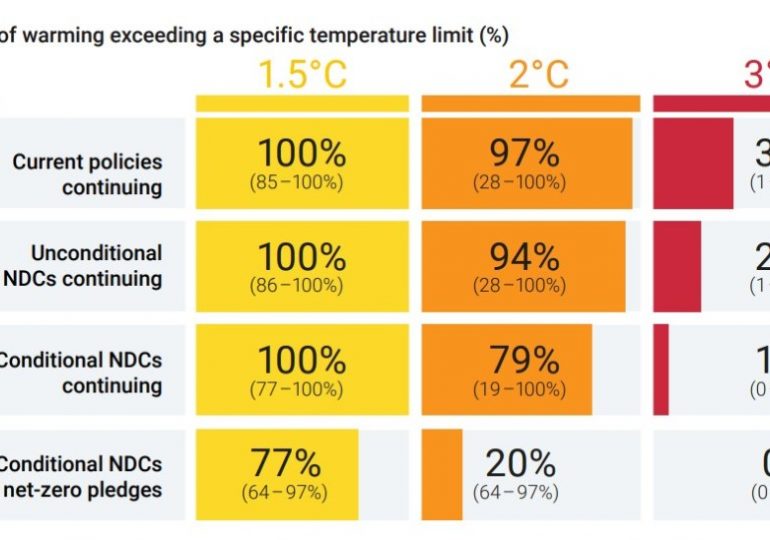In the weeks before a UNFCCC COP, the UN Environment Programme (UNEP) traditionally publishes its Emissions Gap Report. The report assesses the latest scientific studies on current and estimated future greenhouse gas emissions and compares these with the emission levels permissible for the world to progress on a least-cost pathway to achieve the goals of the Paris Agreement. This year is no exception, and so we saw the Emissions Gap Report 2024 published on October 24th. It makes for sobering reading, with the headline statement being that unless there is an increase in emissions mitigation ambition in new nationally determined contributions (NDC) and that these start delivering immediately, the world is on course for a temperature increase of 2.6-3.1°C within this century vs. 1850-1900. In her foreword to the report, the UNEP Executive Director, Inger Andersen, states that current NDC promises are putting us on track for best-case global warming of 2.6°C this century.
There is no doubt that anthropogenic greenhouse gas emissions are continuing to rise, but given the state of the energy transition, is it reasonable to say the world is on track for 2.6-3.1°C of warming through lack of action?
The answer comes down to ways in which the future is assessed. The UNEP outcome is essentially a projection based on current policy trends, or a forecast derived from what governments have said they will do. They have rightly recognized that current NDCs, which stretch to 2030, do not contain sufficient reductions to lower emissions in line with the 2021 Glasgow Climate Pact (the outcome of COP26, targeting a 45% reduction of CO2 emissions by 2030 relative to 2010 levels). But after 2030, the outcome they project (i.e. 2.6-3.1°C of warming this century) is based on an assumption of only modest ongoing changes in the energy system as an extension of what the current NDCs say will happen in the period 2025 to 2030. This of course gives a rather depressing outlook, and is shown in the top line of the table below taken from the UNEP report.
Note: Unconditional NDCs are those which a country will implement through its own resources, whereas conditional NDCs are dependent on a country receiving financial help from other Parties for implementation.
Of course, it’s not for UNEP to state what specific countries should do, so it’s not a surprise that their projection comes about as discussed. But it’s also not a fair representation of how progress in the energy transition will likely play out. For that, a different tool, other than projections, is needed. In Shell, we use scenarios, as do many other organisations.
Scenario analysis is a technique that helps businesses and organizations plan for the future by considering the potential impact of current and future events and trends. It’s a valuable tool for strategists and leaders to think about how the world is changing and what that means for society. Scenario analysis involves considering various trends seen in the present and using them to offer different options for future development paths. It’s a forward-looking “what if” analysis that challenges conventional wisdom about the future. When the world is looked at through such a lens, a very different outcome emerges.
In The Energy Security Scenarios published by Shell in March 2023, two alternative futures are presented, namely Sky 2050 and Archipelagos. Both start with the realities of the 2020s, including the lack of progress towards the 2030 ambition within the Glasgow Climate Pact. As time moves on into the 2030s, Sky 2050 takes a normative approach that starts with the desired outcome of global net-zero emissions in 2050 and works backwards in time to explore how that outcome could be achieved. By focusing on security through mutual interest, the world achieves the goal and a global temperature rise of less than 1.5°C in 2100. Archipelagos follows a possible path in a world focusing on security through self-interest. Even so, change is still rapid, and the world is nearing net-zero emissions by the end of the century.
For this discussion, I will just focus on Archipelagos, as it is exploratory in nature rather than goal seeking, or normative. The scenario is built on the foundations of what we are seeing today, which includes a rapid growth in electric vehicle production, a burgeoning solar PV sector, growing use of batteries and the beginnings of a hydrogen economy. But it also builds on the general antipathy towards carbon removals, such as through direct air capture (DAC) of CO2, and it embraces the somewhat divisive geopolitics currently in play, with security being uppermost in the minds of global leaders.
Archipelagos presents us with a challenging geopolitical environment, but not one in which the energy transition just plays out at the current rate. It accelerates as countries seek security, as technologies further mature and as climate concerns grow, albeit not as a primary driving force in society. Energy policies do change, although the focus may not be minimizing emissions, and this is seen in the lacklustre development of the carbon capture and storage (CCS) industry and the collapse of the DAC technology pathway. Oil, coal and gas all peak in the 2030s and demand starts to decline, as shown in the chart above. Both the power generation and passenger road transport sectors change rapidly, but full and comprehensive change throughout the entire energy system takes the best part of a century to unfold.
The above narrative, chart and the century long timetable may look and sound alarming, but an analysis of greenhouse gas emissions in the scenario (performed for Shell by the MIT Center for Sustainability Science and Strategy) shows that warming reaches a plateau of 2.2°C by 2100. This isn’t in line with the Paris Agreement, but not as sobering as the UNEP projection of 2.6-3.1°C either.
Rather than simply project the future based on today’s numbers, scenario analysis points to a very different outcome in which the world is at least nearing the upper threshold of 2°C in the Paris Agreement. Scenario analysis embraces the dynamic nature of the energy system as a variety of policies, technologies and consumer preferences force change. The lesson from Archipelagos is that change is underway and at least by the end of the century fossil fuel use will have been largely phased out (about 15% of energy use vs. 78% now, excluding petrochemicals).
The NDC focus by UNEP is particularly important in 2024, as the Paris Agreement requires that countries update their submissions by February 2025, with a focus on their actions to 2035. The scenario analysis presented above is not designed to encourage complacency on the back of inevitable change, but rather to encourage policy makers to focus on areas where they can make a material difference. While Sky 2050 proceeds faster than Archipelagos in almost every aspect of the transition, there is one stark difference between the two scenarios. Sky 2050 embraces the need for carbon removals, through CCS, DAC and much improved land management.
To reach the goal of the Paris Agreement, including ‘well below 2°C’, society needs to embrace carbon management and the set of technologies and practices that go with it. While the world should not take the rest of the energy transition for granted, it is nevertheless well underway.
Note: Shell Scenarios are not predictions or expectations of what will happen, or what will probably happen. They are not expressions of Shell’s strategy, and they are not Shell’s business plan; they are one of the many inputs used by Shell to stretch thinking whilst making decisions. Read more in the Definitions and Cautionary note. Scenarios are informed by data, constructed using models and contain insights from leading experts in the relevant fields. Ultimately, for all readers, scenarios are intended as an aid to making better decisions. They stretch minds, broaden horizons and explore assumptions.
Leave a comment



